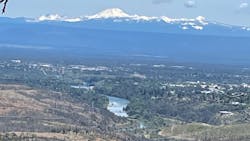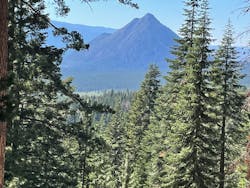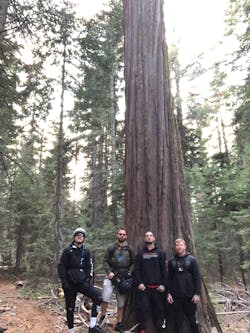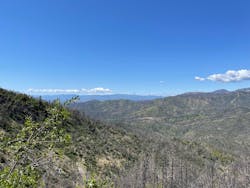Vegetation Management: Learning from the Wisdom of Our Ancestors
For thousands of years, Indigenous people around the world have been living sustainably and in harmony with the environment. They have developed unique traditional land and vegetation management practices that have been passed down through generations. This category of knowledge, referred to as Traditional Ecological Knowledge (TEK), promotes the health and vitality of the land, plants and animals in each of their respective geographies.
The Indigenous groups in North America have a rich history of traditional land and vegetation management practices allowing them to live sustainably for thousands of years. For example, the Redding Rancheria comprises three neighboring tribes: the Wintu, Pitt River and Yana people. These tribes are known to use traditional vegetation management practices to care for the land.
The tribes that make up the Redding Rancheria have a long history dating back more than 10,000 years. For centuries, these tribes managed the forests with an understanding of the need to promote healthy growth of new resources. Also, they strive to reduce the abundant fuels that could lead to fires, which could cause damage to the soils and vegetation the tribes rely on for food and other resources. It’s important to the people, the animals, insects, and all life to properly care for the land.
Managing the Land
After European settlers made their way west to California, the tribes’ traditional methods of managing the forests were halted. Most of the forest lands were taken by the government and for subsequent decades, mismanaged by government agencies and timber companies. Restoring these forests to a state where they can use traditional vegetation management practices will require a lot of work. The tribes need to reduce the fuel that has been building up for centuries to safely burn without destroying the soil, trees, vegetation and habitat for all life in these forests.
The traditional land and vegetation management practices of these tribes have been developed over centuries and are essential for the sustainability of the land and its resources. These practices are deeply rooted in the culture and traditions of the tribes and are an essential part of the tribes’ cultural heritage. The tribe’s traditional practices provide important lessons for modern land management strategies and can help to promote a healthier and more sustainable environment for future generations.
Strategies for Sustainability
As a proud member of the Redding Rancheria Tribe, I am honored to share our traditional land and vegetation management practices that have allowed us to live sustainably in the region for thousands of years. Our practices have been developed over centuries to promote the health and vitality of the land, plants and animals in the region. These practices have been passed down through generations and have been a cornerstone of our culture and way of life.
One of the most important land and vegetation management practices used by our people was the use of controlled burns. Controlled burns were used to clear the land of dead brush and other debris, which helped to reduce the risk of wildfires. This practice also promoted the growth of certain plants, such as acorns, which were an important food source for the tribe. Our people understood that controlled burns were a natural way to maintain the ecosystem and promote plant growth while also reducing the risk of larger devasting wildfires.
Our people also had, and have today, a deep respect for the natural resources in the region. The tribe used natural resources, such as water and timber, in a sustainable manner, only taking what was needed and leaving enough for future generations. This practice helped to ensure that the region remained healthy and sustainable.
Our people understood that taking care of the land and its resources was critical for our survival and the survival of our future generations. Growing up we were always taught to make decisions for the prosperity and health of our seventh generation. Today we are still making decisions to ensure we preserve the forests for our own seventh generation.
These traditional land and vegetation management practices have been passed down through generations and have helped to ensure the sustainability of the land and the health of the ecosystem. They have also been a cornerstone of our culture and way of life. Our people have always understood the importance of living in harmony with the land and have worked tirelessly to maintain this balance.
A Global Perspective
Our traditional land and vegetation management practices are not, however, unique. Many other Indigenous people around the world have similar practices that are designed to promote the health and vitality of the land and the environment.
The Sámi people of Scandinavia have a long history of land and vegetation management practices. These practices include the use of controlled grazing and selective harvesting, as well as the management of wildfires using traditional burning practices. The Sámi people have also developed a deep understanding of the ecology of the region and the importance of maintaining the health of the ecosystem.
The Karen people of Thailand also have traditional land and vegetation management practices that have been developed over centuries. These practices include rotational farming, where fields are left fallow for several years to allow the land to recover, and the use of natural fertilizers, such as animal manure. The Karen people also practice controlled burning, which helps to clear the land of dead vegetation and promotes the growth of new vegetation.
The Haudenosaunee Confederacy, also known as the Iroquois Confederacy, is an Indigenous confederacy made up of several tribes in the northeastern United States and southeastern Canada. The Haudenosaunee have a long history of sustainable land management practices, including the use of controlled burning to promote the growth of certain plant species and the use of fish weirs to manage fish populations in rivers and streams.
The Indigenous people of the Amazon rainforest in South America use slash-and-burn agriculture to create fertile land for farming. Unlike the widespread current clear cutting of forests in the Amazon region, this traditional practice is done in a sustainable way. Only a small portion of the forest is cleared at any given time and the land is left fallow for several years to allow the forest to recover.
The Maori people of New Zealand also have traditional land and vegetation management practices that have been developed over centuries. These practices include the use of controlled burns to manage forests, the planting of certain trees to promote soil health and the use of traditional fish traps to manage fish populations in rivers and streams.
Benefits of Traditional Practices
Traditional land and vegetation management practices, such as controlled burns, help to reduce the risk of large-scale wildfires by reducing the amount of flammable vegetation and promoting the growth of certain plant species. These practices have been used for centuries by indigenous people and have been shown to be effective in preventing wildfires.
In addition, the practices help to promote biodiversity by ensuring that the land is healthy and vibrant, which in turn provides habitat for a range of animal species. By managing the land and vegetation in a sustainable manner, these practices help to create a diverse and resilient ecosystem.
The revival of these, and other traditional land and vegetation management practices, could be beneficial for environmental and fire mitigation purposes. These practices have been used for centuries by indigenous people and have been shown to be effective in promoting a healthy and sustainable environment.
To revive these practices, we must first acknowledge the importance of traditional knowledge and practices. We must recognize the contributions of Indigenous people to the development of sustainable land management practices and work to incorporate these practices into modern land management strategies where possible.
Education is also essential in reviving traditional land and vegetation management practices. We must work to ensure that young people are educated about the importance of these practices and the role they play in creating a healthy and sustainable environment.
Traditional land and vegetation management practices have been used by Indigenous people for centuries and have proven to be effective in promoting a healthy and sustainable environment. By incorporating these practices into modern land and vegetation management strategies, we can reduce the risk of wildfires, promote biodiversity, preserve cultural heritage and ensure the long-term sustainability of our natural resources. As we face increasing environmental challenges, we must learn from the wisdom and knowledge of Indigenous people and work collaboratively to create a healthier and more sustainable world for future generations.
Jeremy Hayward ([email protected]) is the president of Redding Rancheria Economic Development Corporation and a director of Essential Vegetation Management Services, LLC, a tribal-owned business that supports utilities, governmental entities, and commercial businesses that require critical vegetation services to mitigate fire risks.
About the Author
Jeremy Hayward
Jeremy Hayward ([email protected]) is the president and director of essential vegetation management services of the Redding Rancheria Economic Development Corporation.





